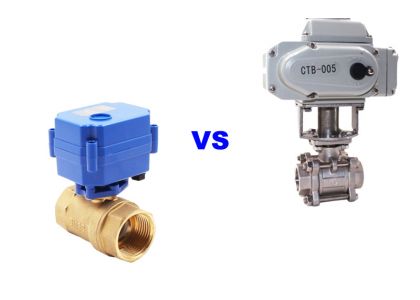
Both miniature motorized ball valves and industrial-grade motorized ball valves are electrically actuated ball valves used for water treatment control. However, miniature motorized ball valves are designed for smaller automation equipment or piping systems, while industrial-grade valves are more commonly found in large-scale manufacturing facilities and water treatment plants. Key distinctions between the two lie in valve size, operating voltage, and working pressure.
Differences Between Miniature Motorized Ball Valves and Industrial-Grade Motorized Ball Valves
Size Differences: Micro electric actuated ball valves are typically designed for small diameters, with common sizes ranging from 1/4“ to 2”. They are suitable for installation in compact spaces. Industrial electric actuated ball valves, however, generally feature larger diameters, such as 2“ to 12” and above. They are suitable for large-diameter pipelines.
Voltage: 1/4“-2” motorized valves typically operate on low voltages such as DC12V and DC24V, while large-bore motorized ball valves often accommodate higher voltages ranging from AC220V to AC380V to support actuators with greater torque requirements.
Working Pressure: Miniature ball valves typically operate within a pressure range of 1.0 MPa to 1.6 MPa, making them suitable for low-to-medium pressure applications. Industrial-grade ball valves, however, can withstand high pressures up to 4.0 MPa (40 bar), meeting the demands of high-pressure operating conditions.
Recommendations for Selecting Motorized Valves
Prioritize checking the required voltage specifications and pressure ratings. For more information, please refer to professional valve manufacturer websites such as Jinfeng Valve.
Comprehensive Analysis of Motorized Ball Valves
Differences in Valve Sizes
Valve diameter is the core parameter distinguishing miniature motorized ball valves from industrial-grade motorized ball valves.
Miniature motorized ball valve sizes: Featuring compact designs, common diameters range from 1/4“, 1/2”, 1“, to 2” motorized ball valve. Available with NPT or BSP threads. Suitable for residential water systems and small-scale automation equipment.
Industrial-grade motorized ball valve size: Industrial-grade valves feature larger nominal diameters, ranging from 2“ to 8” motorized ball valves and even larger sizes. This makes industrial-grade valves suitable for large-diameter pipelines.
Voltage Specifications
Miniature motorized ball valves are typically designed for low voltage to minimize energy consumption. Common motorized ball valve voltages include DC5V, DC12V, and DC24V. These voltage specifications are suitable for low-power equipment and help avoid risks associated with high voltage.
Industrial-grade motorized ball valves are compatible with voltages including DC12V, DC24V, AC110V, AC220V, and AC380V. This design incorporates a three-phase power supply, enabling higher torque output. It ensures stable actuator operation under high voltage conditions.
Working Pressure
The working pressure of miniature ball valves is generally limited to the low-to-medium pressure range, typically operating at 1.0 MPa and 1.6 MPa. This pressure range is suitable for media such as water and air, with an operating temperature range of 0°C to 95°C. They are not recommended for high-pressure applications.
Industrial-grade motorized ball valves can withstand higher working pressures up to 4.0 MPa (approximately 40 bar) and operate within a temperature range of -10°C to 180°C. They are commonly used in oil drilling or high-pressure cleaning equipment.
Other Key Differences
Materials and Durability: Miniature motorized ball valves commonly use brass, stainless steel, and PVC materials. Industrial-grade valves predominantly employ stainless steel and forged materials for enhanced strength.
Actuation Time: Miniature electric actuators typically achieve actuation in under 10 seconds, with some models reaching 3 seconds. Industrial-grade actuators deliver higher torque but require longer actuation times, generally ranging from 30 to 100 seconds.
Summary
The distinction between miniature motorized ball valves and industrial-grade motorized ball valves lies in their scale and strength. The former is suitable for small-scale automation control applications, while the latter is designed for high-intensity industrial environments. By considering these parameters, you can better select the appropriate valve for your needs.